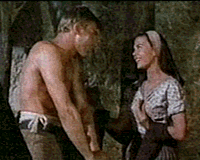

Cast Credits
- Tab Hunter - Trace Jordan
- Natalie Wood - Maria Colton
- Skip Homeier - Jack Sutton
- Eduard Franz - Jacob Lantz
- Earl Holliman - Mort Bayliss
- Claude Akins - Ben Hindeman
- Ray Teal - Joe Sutton
- Frank Puglia - Tio Perico
- Hal Baylor - Braun
- Tyler MacDuff - Wes Parker
- Rayford Barnes - Veach
- Tony Terry - Vincente Colton
Production Credits
- Director - Stuart Heisler
- Screenplay - Irving Wallace
- Source Material (from novel) - Louis L'Amour
- Producer - Richard Whorf
- Assistant Director - Chuck Hansen
- Director of Photography - Ted McCord
- Editor - Clarence Kolster
- Music - David Buttolph
- Costume Design - Marjorie Best
- Producer - Richard Whorf
This western opens well enough; we see three men from the waste down as they sneak up on a fourth man, who is chopping wood, and shoot him in the back. The man's brother, Trace Jordon, looks at their tracks and sees from their footprints that one is lame and another wears fancy Mexican spurs, the third left a cigar butt. He follows them into town with the intention of seeing the sheriff; however his office has been destroyed. He soon learns that the men all work for Joe Sutton; the local major landowner who is trying to clear everybody else from the area so he owns the whole valley by the time it comes to register ownership. Trace confronts Sutton and in the ensuing gunfight Sutton is wounded. Trace rides off but is shot in the back. When he wakes up he finds his horse has carried him to the well of a local sheep farm. Here he is helped by Maria-Christina Colton, a woman whose father was murdered by Sutton. When the posse of Sutton's men arrives she claims to have no idea where Trace is. She drugs their coffee then escapes to meet up with Trace. From then on they struggle to keep ahead of the posse so they can get to the nearest army outpost and report the murder of Trace's brother.
There are plenty of clichés in this minor example of the western genre; a brother seeking revenge, a woman who eventually falls for his charms and a gang of vicious thugs who will shoot a man in the back or force themselves on a woman given half a chance; the only ones in the group with any standards were the half-Indian tracker and their leader and the latter was shot in the back by Sutton's son fairly early into the pursuit. The acting was good enough; Natalie Wood was suitably feisty as Maria although I don't think her accent would fool any real Mexicans! Tab Hunter was a decent enough lead but Skip Homeier made more of his role as the unpleasant Jack Sutton. The action was decent and the final fight between Trace and Sutton looked genuinely painful at times; of course being made when it was the shootings look a little unbelievable; I'm sure even a minor wound would leave a bigger blood patch than we saw here! Overall it was a reasonable will that fans of the genre may like, it contains nothing to offend so is suitable for younger viewers who like a bit of action too.
There are plenty of clichés in this minor example of the western genre; a brother seeking revenge, a woman who eventually falls for his charms and a gang of vicious thugs who will shoot a man in the back or force themselves on a woman given half a chance; the only ones in the group with any standards were the half-Indian tracker and their leader and the latter was shot in the back by Sutton's son fairly early into the pursuit. The acting was good enough; Natalie Wood was suitably feisty as Maria although I don't think her accent would fool any real Mexicans! Tab Hunter was a decent enough lead but Skip Homeier made more of his role as the unpleasant Jack Sutton. The action was decent and the final fight between Trace and Sutton looked genuinely painful at times; of course being made when it was the shootings look a little unbelievable; I'm sure even a minor wound would leave a bigger blood patch than we saw here! Overall it was a reasonable will that fans of the genre may like, it contains nothing to offend so is suitable for younger viewers who like a bit of action too.
CRITICA EN EL PERIODICO "LA VANGUARDIA" (31-3-1962)
"Western" clásico y típico, con todos los requisitos, bastante elementales y primitivos, que exige este género, tal como se hacían en los tiempos de Tony Mix. El color y el cinemascope han provisto a la realización relieve y novedad. Por lo demás, se diría que por el cine "por el cine de Stuart Heísler, realizador del film" no ha pasado el tiempo. El clima, el argumento, los paisajes y los personajes son los clásicos. Hay grandes galopadas, tiros a granel, un combate con los indios comanches, previsibles peleas cuerpo a cuerpo y una persecución persistente, infatigable frenética y cruel, en la que los "malos", los perseguidores, que son muchos, acaban siendo liquidados por el "bueno", que es uno sólo. Pero éste es un hombre joven, templado y de gran corazón, a quien Dios y el amor "éste en forma de una guapaza mestiza" ayudan a escapar ileso de todos los riesgos y acechanzas. Naturalmente, todo esto no deja de tener su emoción. Emoción ingenua, unas veces; otras vigorosa, y otras enrevesada de la sorpresa que tales abominables seres hayan podido poblar algún día el Oeste americano. En ocasiones, uno pregunta cómo si todos estos horrores eran cosa corriente en el Far West, para nadie llegar a viejo en aquellas tierras ásperas, desérticas y ardientes. Pero la verdad es que sobrevivieron aunque fuesen pocos. En "Colinas Ardientes" sólo escapa con vida uno "el bueno" de los treinta o cuarenta que entran en acción. Es posible que de esta manera "es decir matando tantos malos" el país se depurará y haya llegado a ser la gran nación que és hoy. Enfocadas las cosas así "como grandes matanzas de malos" el western viene a darnos una visión muy elocuente y expresiva de la historia de Estados Unidos. Todos los malos murieron en el Oeste a manos de los buenos, con infalible puntería. Luego, los buenos van liderando, como era natural. El film, ha sido realizado en color con bastante pericia. La camara es movida con precisión y tino, los hoscos personajes "westernianos" aparecen caracterizados con esa sorprendente maestría a que ha llegado en el género el cine de Hollywood. Los dos principales intérpretes son Tab Hunter "no hay que confundir con Jefrey Hunter" y Natalie Wood. Son dos artistas jóvenes, pero de gran temperamento, y destinados a alcanzar el estrellato sólido. Sobre todo, ella una joven de fuerte personalidad y original belleza, con grandes ojos negros y un buen estilo de comedianta, dando vida, a la figura de una mestiza de yanqui y mejicana. Natalie Wood alcanza realmente cotas de gran acierto. A. MARTÍNEZ TOMAS.
contador visitas




























.JPG)


















Thanks for your comment, Paco Granados
ReplyDelete